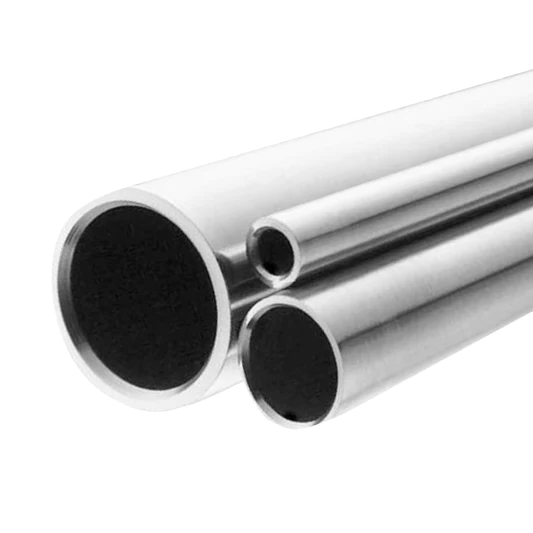Difference Between Stainless Steel Seamless And Welded Pipe & Tube
A stainless steel pipe is a tube made mostly from stainless steel, a special metal that doesn’t rust easily. These seamless and welded stainless steel pipe are used in many industries because they last long, can be used in different ways, and are clean to use.They are made in different ways, like welding or seamless manufacturing, depending on what they’re needed for. Stainless steel pipes come in various sizes, thicknesses, and types, so they can fit different jobs easily.


SS Steel Pipe :
Smls pipe are formed without any welding seams.They’re made by piercing a solid steel billet to create a hollow tube.Seamless pipes are stronger and more resistant to pressure because they don’t have weld seams.They’re preferred for high-pressure situations and where corrosion resistance is crucial.Seamless pipes are usually more expensive due to their complex manufacturing process.
Stainless Steel Seamless Pipe manufacturing Process :
1. Material Preparation: Stainless steel billets or ingots are selected and prepared for further processing.
2. Heating: The billets are heated to high temperatures in a furnace to make them malleable.
3. Piercing: The heated billets are pierced with a mandrel to create a hollow tube.
4. Rolling and Sizing: The pierced billet is rolled and elongated to the desired diameter and thickness using rolling and sizing mills.
5. Annealing: The tube undergoes annealing, where it is heated and cooled slowly to relieve stress and improve mechanical properties.
6. Straightening and Cutting: The annealed tube is straightened and cut to the desired length.
7. Finishing: The finished pipe may undergo processes like polishing, pickling, or passivation to remove imperfections and enhance corrosion resistance.
8. Quality Control: Throughout the process, the pipe undergoes rigorous quality control inspections.
9. Final Inspection and Packaging: Once it meets standards, the pipe undergoes a final inspection before being packaged and shipped.
Welded Stainless Steel Pipe :
Welded pipes are made by welding stainless steel plates or coils together.They may have weld seams along their length, which can be weaker points.Welded pipes are used in less severe conditions and are more cost-effective.They’re made using different welding techniques like electric resistance welding or fusion welding.
How is Welded stainless steel pipe made :
1. Material Preparation: Choose stainless steel coils or sheets for processing.
2. Forming: Shape the coils or sheets into a tube using a forming machine.
3. Welding: Join the edges of the formed tube using welding techniques like electric resistance welding or laser welding.
4. Sizing and Straightening: Pass the welded tube through sizing rollers to get the right diameter and thickness. Straighten if needed.
5. Annealing (Optional): Heat and cool the welded pipes slowly to enhance their strength and properties.
6. Cutting: Use saws or shearing machines to cut the welded pipes to the desired length.
7. Finishing: Polish, pickle, or passivate the pipes to remove imperfections and improve corrosion resistance.
8. Quality Control : Check the pipes thoroughly during manufacturing to ensure they meet dimensional accuracy and welding standards.
9. Final Inspection and Packaging : Inspect the pipes one last time before packing them securely for shipping to customers. Protect the pipes to prevent damage during transit and storage.
Both seamless and welded stainless steel pipes have their advantages and disadvantages, the choice between them depends on factors such as the application requirements, operating conditions, budget constraints, and structural considerations.
Stainless steel seamless and ERW (Electric Resistance Welded) pipes are extensively used across various industries due to their unique properties and suitability for different applications. The grade chosen depends on what each industry needs specifically.
- Chemical Processing Industry: Both seamless and ERW stainless steel pipes are used for conveying corrosive fluids and chemicals in chemical processing plants. Grades commonly used include 304, 316 pipe , and 321 stainless steel tubing due to their excellent corrosion resistance properties.
- Oil and Gas Industry: Seamless and ERW stainless steel pipes find applications in the oil and gas sector for transporting oil, gas, and other hydrocarbons. Grades such as 304, 316, and duplex stainless steels like 2205 are commonly used due to their corrosion resistance and durability.
- Petrochemical Industry: Stainless steel pipes are essential in petrochemical facilities for handling various chemical processes and applications. Grades like 304, 316, and duplex stainless steels are preferred for their corrosion resistance and ability to withstand high temperatures and pressures.
- Food and Beverage Industry: Seamless and ERW stainless steel pipes are widely used in food processing and beverage manufacturing for conveying fluids and ingredients safely. Grades such as 304 and 316L stainless steel are commonly used due to their hygienic properties and resistance to bacterial growth.
- Pharmaceutical Industry: Stainless steel pipes play a crucial role in pharmaceutical manufacturing facilities for transporting pharmaceutical ingredients and maintaining sterile environments. Grades like astm a 312 tp 316l and 316Ti stainless steel are preferred for their smooth surface finish and cleanliness.
- Water Treatment Plants: Stainless steel pipes are used in municipal water treatment facilities for conveying water and chemicals. Grades like 304 and 316 stainless steel are commonly used due to their corrosion resistance and durability.
- Construction and Architecture: Both seamless and ERW stainless steel pipes are utilized in architectural designs and construction projects for structural components, handrails, and decorative elements. Grades like 304 and 316 stainless steel pipe are preferred for their aesthetic appeal and durability.
- Automotive Industry: Stainless steel pipes find application in the automotive sector for exhaust systems, chassis components, and fuel delivery systems. Grades like 409 and 304 stainless steel are commonly used due to their corrosion resistance and durability.
- Aerospace Industry: Stainless steel pipes are used in the aerospace industry for various applications such as hydraulic systems, structural components, and engine parts. Grades like 304 and 316 stainless steel are preferred for their lightweight nature, corrosion resistance, and high strength-to-weight ratio.
- Power Generation: Seamless and ERW stainless steel pipes are utilized in power plants for steam and water supply lines, boiler tubes, and heat exchangers. Grades like 304H and 316H stainless steel are commonly used for their ability to withstand high temperatures and pressures.

